1. About Cell and Cell Theory
The Fundamental Unit of Life
Introduction of cell
The introduction to cell began back in the year 1655 when a revolutionary observation was made by an English scientist Robert Hooke.
In all the living beings, cells are the basic structural units. We can compare the presence of cells in our body to the bricks in a building. All the bricks are assembled to make a building. Similarly, all the cells are assembled to make the body of an organism.
Thus, it is the basic structural and functional unit of life and all the organisms are made up of cells. The subcellular structures of the cell comprise of the plasma membrane, organelles and in some cases a nucleus as well. As for the size of the cell, it is variable and maybe anything from 1 to 100 micrometre.
Robert Hooke was examining a dried section of the cork tree using a crude light microscope. In this analysis, he observed multiple small chambers which he named the cells.
The first theory was proposed by the German botanist Matthias Jacob Schleiden and the German physiologist Theodore Schwann in 1838. This theory was formalized in the year 1858 by the German researcher Rudolf Virchow by suggesting that all cells arise from pre-existing cells.
Cell Theory
• The cell is the basic functional and structural unit of life. All the living organisms are composed of cells.
• All cells are formed by the division of the already existing cells which in terms of biology means reproduction. Every cell of our body comprises of genetic material which is passed down during the process.
• All the basic physiological and chemical functions i.e. the growth, repair, movement, communication, immunity and digestions are performed inside the cells.
• All the activities of the cell depend mainly on the activities of the subcellular structures that lie within the cell. These subcellular structures comprise of the plasma membrane, organelles and if present, the nucleus.
Types of Cells
Broadly, there are two key types of cells i.e., the Prokaryotic Cell and the Eukaryotic Cell. The difference between the two is defined mainly by the presence or the absence of the nuclear membrane.
- Prokaryotic Cell
If a cell has a nuclear material without a nuclear membrane, then it is known as the prokaryotic cell, where ‘pro’ stands for primitive and ‘karyon’ stands for the nucleus. Some of the organisms that have prokaryotic cells include bacteria and the blue-green algae.
- Eukaryotic Cell
If a cell has a nuclear material with a nuclear membrane, then it is known as the Eukaryotic Cell, where ‘EU’ stands for true and ‘karyon’ stands for the nucleus. All the living organisms except bacteria and blue-green algae have Eukaryotic Cells.
2. Cell Membrane and Cell Wall
Cell Size
The cell size is variable. In the living organisms, the cell size may be as small as a millionth of a metre or may be as large as a few centimetres. Usually, all the cells are microscopic in size and aren’t visible to the naked eye. Thus, they need to be enlarged by a microscope for seeing.
Cell Shape
- Usually, the cells are round, elongated or spherical.
- There are also some cells which are long and pointed on both the ends. Such cells exhibit spindle shape.
- In some cases, the cells are very long.
- Some may be branched like the neuron or the nerve cell. The nerve cell transfers and receives messages.
It, therefore, helps in coordinating and controlling the working of the different parts of the body. The components of the cell are enclosed in a membrane. This membrane provides shape to the cells of animals and plants. There is a cell wall surrounding them. The cell wall is an additional covering over the cell membrane in the plant cells. It offers rigidity and shape to the cells.
Depending on the purpose, the cell takes on a number of forms. Cells come in a variety of forms, including:
Skin cells
- These skin cells have a flat surface.
- They are a protective body cover with a flat form that allows them to cover a large area.
Muscle cells
i. Muscle cells are long, thin, and elongated.
ii. Muscle cells expand and contract, and their long and thin structure aids in this process.
Nerve cells
i. These nerve cells have a lengthy fibrous structure.
ii. Long, thin extensions (axons and dendrites) connect these nerve cells to other nerve cells.
iii. The extensions aid the neuron in swiftly transmitting chemical and electrical information throughout the body.
iv. Nerve cells can contain fibres that are over a metre long.
v. Messages are transmitted down these fibres from one nerve cell to the next.
Blood cells
i. White blood cells are disc-shaped but have the ability to alter form.
ii. WBC in the blood alters their form to kill bacteria or any pathogens that are disease-causing organisms. iii. The structure of red blood cells (erythrocytes) allows them to pass through capillaries with ease.
Plant cells
i. Depending on their purpose, plant cells might be rectangular, circular, oval, or elongated. Plant cells on the outside of the stem give the plant its strength.
ii. For support, these cells have strong cell walls. Food is stored in specific cells in plants, and these cells are bigger than other cells.
Cell Wall
The cell wall is the outer covering of a cell, present adjacent to the cell membrane, which is also called the plasma membrane. The cell wall is normally present in all plant cells, fungi, bacteria, algae, and some archaea. Animal cells are not regular in their shape and this is mainly due to the lack of cell walls in their cells. Cell wall composition usually varies along with organisms.
The Function of the Cell Wall
There are various functions of cell wall like:
• The cell wall of the plants provides definite shape, strength, and rigidity.
• The cell wall also protects against mechanical stress and physical shocks.
• Cell wall helps to control cell expansion due to the intake of water.
• The cell wall also helps in preventing water loss from the cell.
• The cell wall is responsible for transporting substances between and across the cell.
• The cell wall acts as a barrier between the interior cellular components and the external environment.
Cell Membrane
• The cell membrane is also called the plasma membrane.
• Cell membrane is found in all cells and separates the interior of the cell from the outside environment.
• The cell membrane also consists of a lipid bilayer that is semipermeable.
• The cell membrane is also responsible for the transportation of materials entering and exiting the cell.
• The thin membrane surrounds every living cell, fixing the cell from the environment around it.
• The cell membranes are the cell’s constituents, often large, water-soluble, highly charged molecules such as proteins, nucleic acid, carbohydrates, and substances involved in cellular metabolism.
• The surrounding of the cell membrane is a water-based environment, containing ions, acids, and alkalis that are toxic to the cell, as well as nutrients that the cell must absorb to live and grow.
Functions of the Cell Membrane
• There are various functions of cell membrane-like:
• The cell membrane protects the integrity of the interior cell.
• The cell membrane provides support and maintains the shape of the cell.
• The cell membrane helps in regulating cell growth through the balance of endocytosis and exocytosis.
• It also plays an important role in cell signalling and communication.
• The cell membrane acts as a selectively permeable membrane by allowing the entry of only selected substances into the cell.
1. Introduction-Biodiversity
Diversity in Living Organisms
Introduction
- We all know that there are abundant of living organisms present on the earth. Many organisms are not identical to each other.
- This variety of living beings present on the earth is called as a Biodiversity.
- Here is a separate branch of Biology called Taxonomy which identifies, names and classifies different organisms present on the earth.
- Carolus Linnaeus is known as the Father of the Modern Taxonomy.
- Binomial nomenclature is the naming of organisms with two names- genus and species.
- It was first established by Carl Linnaeus and later adopted by all scientists for the universal naming of organisms.
- The Law of priority is established if the same name is shared by two different species or two different taxa.
- Taxonomy deals with the identification, nomenclature, and classification of organisms.
2. Classification System
Classification of Living Things
• Classification presented by Aristotle – He classified animals on the basis of their habitats – land, water and air.
• But it can be easily observed that the animals that live at a particular habitat say land are still so different from each other.
• Therefore, it was decided to classify the living organisms on the basis of a hierarchy.
• This hierarchical classification was based on the similarities and dissimilarities in the characteristics of the living organisms.
• Organisms having similar characteristics were placed in a similar category.
Why do we need to classify organisms?
1. If we classify organisms into several categories, it will be easier for us to study them.
2. It will help us in understanding how did these organisms evolve.
3. We can also understand how different organisms are related to each other.
4. We can learn why different organisms are found at distinct geographical conditions.
Hierarchy Classification - Formation of Kingdoms
Biologists categorized different organisms into several kingdoms.
|
Classification |
Proposed by |
Type of organisms |
|
|
Two kingdom classification |
Carolus Linnaeus in 1758 |
1. Plants |
|
|
2. Animals |
|||
|
Five Kingdom classification |
Robert Whittaker in 1959 |
1. Monera |
|
|
2. Protista |
|||
|
3. Fungi |
|||
|
4. Plantae |
|||
|
5. Animalia |
|||
|
Carl Woese in 1977 |
1. Monera |
||
|
(i) Archaea |
|||
|
(ii) Eubacteria |
|||
|
2. Protista |
|||
|
3. Fungi |
|||
|
4. Plantae |
|||
|
5. Animalia |
|||
|
|
|
|
|
The order of Classification
1. Kingdom
2. Phylum / Division
3. Class
4. Order
5. Family
6. Genus
7. Species
Species is called as the Basic Unit of Classification. Species is a group of organism which can interbreed with each other. The picture below explains how humans are classified in a hierarchical order.
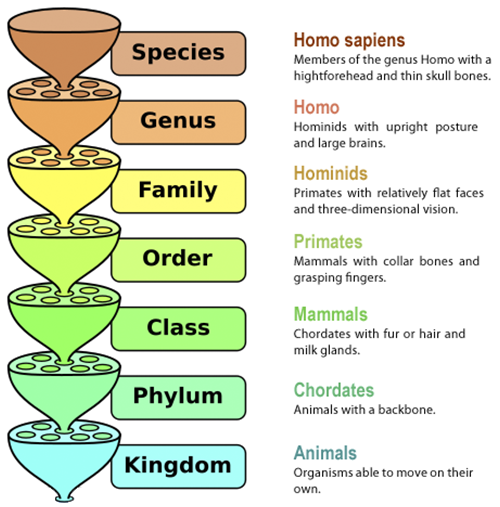
Hierarchical Order of Classifying Humans
Five Kingdom Classifications
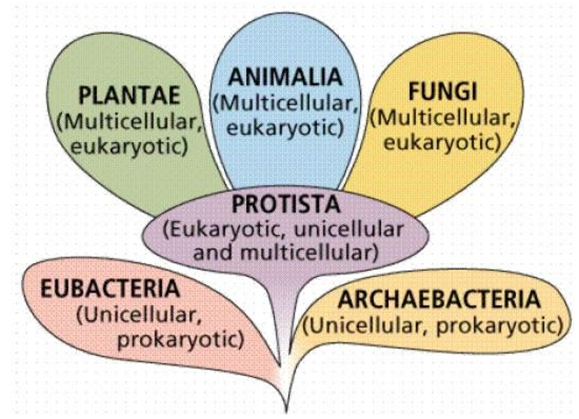
Five Kingdom Classification
- The organization inside the cells
-
- Prokaryotic Cells – Cells with no definite nucleus
- Eukaryotic Cells – Cells with a definite nucleus
- The organization of cells in the body
-
- Unicellular – Single-celled organisms
- Multicellular – Multi-cell organisms
- organisms obtain their food
-
- Autotrophs – Produce their food on their own
- Heterotrophs – Depend on other organisms for their food
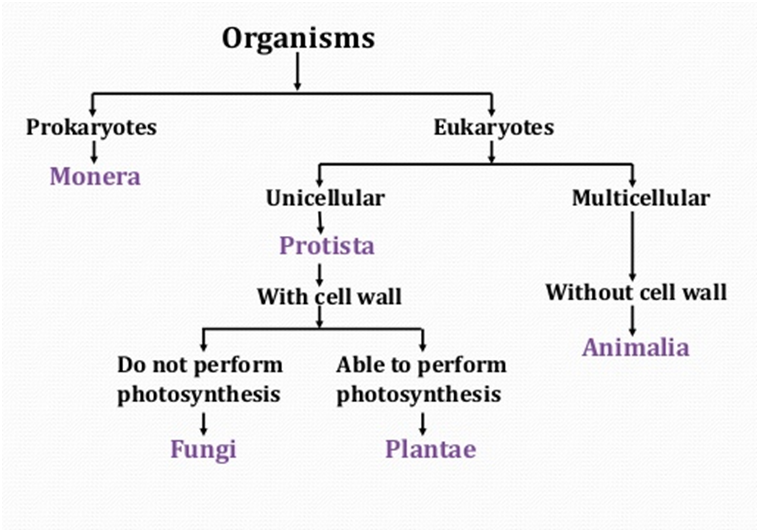
Classification of Organisms
Classification of Organisms
|
|
Monera |
Protista |
Fungi |
Plantae |
Animalia |
|
Organization inside the cells |
Consists of Prokaryotes. |
Eukaryotes – some of them use appendages to move around such as flagella (whip-like structure) and Cilia (hair-like structure) |
Eukaryotes |
Eukaryotes |
Eukaryotes |
|
Organization of cells in the body |
Unicellular |
Unicellular |
Initially unicellular. Can become multicellular in later stages of life |
Multicellular |
Multicellular |
|
Organisms obtain their food |
Some of them are autotrophs like blue green algae while others are heterotrophs |
Both autotrophs and heterotrophs |
Heterotrophs. Most of them are decomposers or may be parasitic. |
Autotrophs |
Heterotrophs |
|
Presence of cell wall |
Some lack a cell wall while others have a cell wall |
Only some have cell wall |
Have cell walls. They are made up of complex sugar called chitin. |
Have cell walls made of cellulose. |
No cell walls |
|
Example |
Blue-green algae, Bacteria, Mycoplasma |
Protozoan, Diatoms and Golden algae |
Yeast and Mushroom ( Agaricus), Rhizopus ( Bread mould), Pencillium |
Flowering plants, moss |
Insects, reptiles |
Archea Kingdom
The monera kingdom is further classified as Archaea.
These are microbes (bacteria) that can live in harsh conditions. Since they can live in extreme temperatures, they are also called Extremophiles.
These organisms lack a cell wall.
Their cell membrane is made up of lipids.
They are further classified into three categories, based on their habitat:
|
Halophiles |
Thermophiles |
Methanogens |
|
These are salt loving bacteria. They live in extremely salty water. |
They live in boiling water such as hot springs and volcanoes. |
They are found in the guts of animals like cow and sheep. They produce methane gas from their dung. |
Who are Saprophytes?
Fungi also called as Saprophytes because they grow over the organic material and survive on them.
What are Symbiotic relationships?
Some species of fungi live in permanent mutually dependent relations with blue-green algae. They are said to have a symbiotic relationship. For Example, Lichens are often found on the bark of the trees.
3. Plant Kingdom
Kingdom Plantae
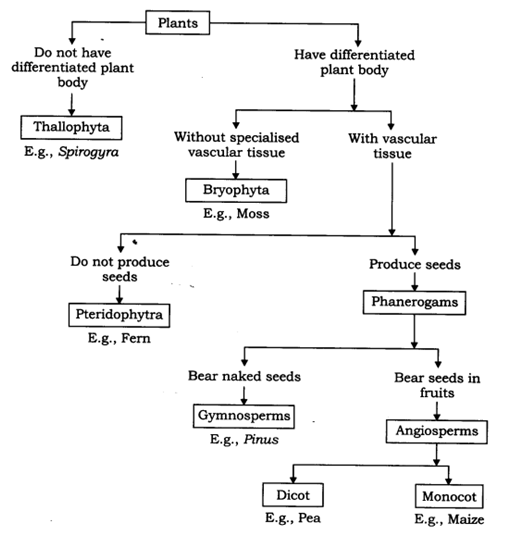
Plant Kingdom
• Components of Plants – whether they are distinct or not
• Presence of Special Tissues in plants for the transportation of food and water
• Presence of Seeds – whether the seeds are present inside the fruits or not.
Classification of plants on the ability to produce seeds -
• Cryptogams – These plants do not have well developed reproductive organs. The organs cannot be seen clearly as well and appear as if they are hidden. Example are Thallophyte, Bryophyta and Pteridophyte.
• Phanerogams – These plants have well developed reproductive organs hence they can produce seeds. They are further classified as the ones which have seeds hidden inside fruits or not - Gymnosperms and Angiosperms
|
Criteria |
Thallophyta |
Bryophyta |
Pteridophyta |
|
Components of plants |
No distinct components. Undifferentiated Body |
Little differentiated body. Distinct components are present as leaves and stem |
Distinct components are present as roots, leaves and stem |
|
Presence of special tissues- Vascular tissue |
No |
No |
Yes |
|
Presence of seeds |
No |
No |
No |
|
Found in |
Aquatic environment, snow |
First terrestrial plants but but need water for sexual reproduction. So called as Amphibian of plant kingdom. |
Terrestrial or dry areas |
|
Example |
Spirogyra, Ulothrix, Volvox |
Moss and liverworts |
Ferns |
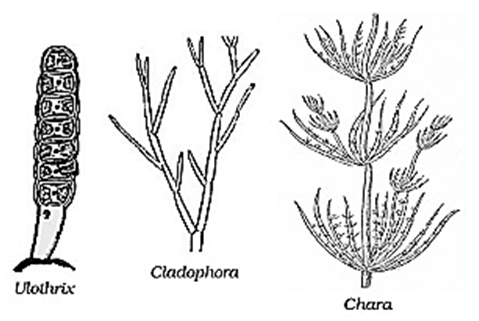
|
|
Gymnosperms |
Angiosperms |
|
The ability to produce seeds |
Naked seeds |
Seeds develop in an organ which then turns into the fruit |
|
Existence |
Exist for long time periods, Evergreen |
Grow for varied time periods |
|
Type |
Woody, No flowers |
Flowering plants |
|
Meaning |
Gymno – naked |
Angio – Covered |
|
Sperm – seeds |
Sperma – seeds |
|
|
Example |
Pines, Deodar |
Mustard, Maize |
What are Cotyledons?
The seed leaves in Angiosperms are called Cotyledons. They turn green on the germination of the seeds. Angiosperms can be divided into two types on the basis of the presence of cotyledons in them-
- Monocotyledons or monocots
- Dicotyledons or Dicots
|
Criteria |
Monocotyledons or Monocots |
Dicotyledons or Dicots |
|
Cotyledons (Seed Leaves) |
Single Cotyledon |
Two Cotyledons |
|
Leaves |
Long leaves, with parallel veins |
Broad leaves with network of veins |
|
Roots |
Fibrous |
Long taproot |
|
Floral Parts |
Multiples of three |
Multiples of four or five |
|
Example |
Corn, Wheat, Grass |
Rose, Sunflower, Lily |
4. Animal Kingdom
Kingdom Animalia
Basic Characteristics of the Animalia Kingdom
1. Animals are eukaryotic, multicellular organisms that lack a cell wall.
2. They are heterotrophs therefore they rely on others for food.
3. They have a growth pattern. The adult animals have a specific shape and size.
4. Most of the organisms have well-defined organ systems such as Respiratory System, Digestion System and so on.
5. Most of the animals can move. They aren’t stationary as Plants.
6. Animals have a nervous system which is why they are able to respond to an external stimulus.
Animals are classified on the basis of differences in their body type and design. The body cavity or coelom in animals contains the organs. Based on the presence of body cavity animals can be categorized as:
1. Coelomate – They have true body cavity called Coelom
2. Pseudocoelomate – It means false cavity. They have a body cavity which is filled with fluid
3. Acoelomate – They have no body cavity at all.
1. Phylum - Porifera
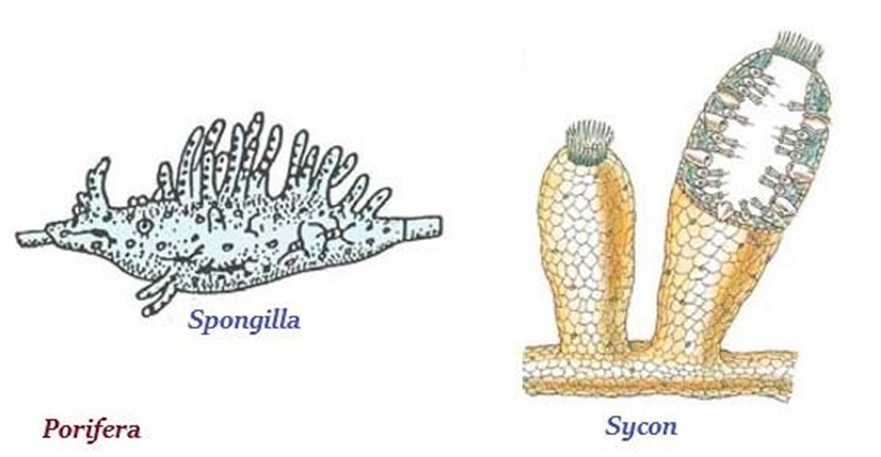
Phylum- Porifera
• Level of Organization – Cells are present
• Symmetry – Asymmetrical
• Segmentation – No segments
• Body Cavity/ Coelom – No
• Presence of Organs – No
• Examples – Sycon, Spongilla, Euspongia
• Other Characteristics-
o They cannot move and are attached to a support.
o They have pores in their body
o These pores form a Canal system through which water and food circulate in the body and waste is removed.
o They have a skeleton made of spongin protein and calcium carbonate – hard covering on them
2.Phylum - Coelentrata
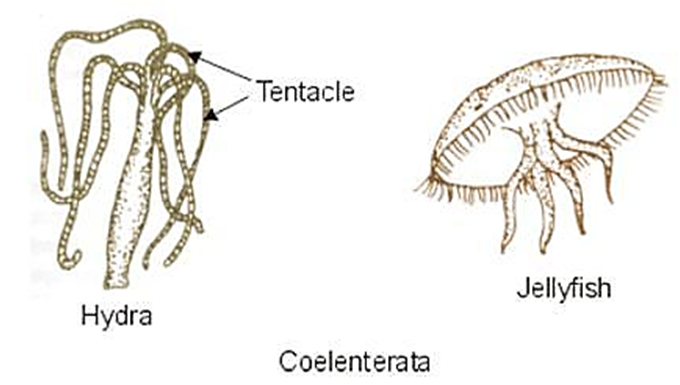
Phylum- Coelenterata
• Level of Organization – Tissues, Cells have two layers – so called as Diploblastic Organism
• Symmetry – Radial
• Segmentation – No segments
• Body Cavity/ Coelom – No
• Presence of Organs – No
• Examples – Aurelia (Jelly fish) and Adamsia (Sea Anemone)
• Other Characteristics –
o Some of them live in colonies - They are physically attached to each other such as Corals
o Some of them live solitary such as Hydra
3.Phylum - Platyhelminthes
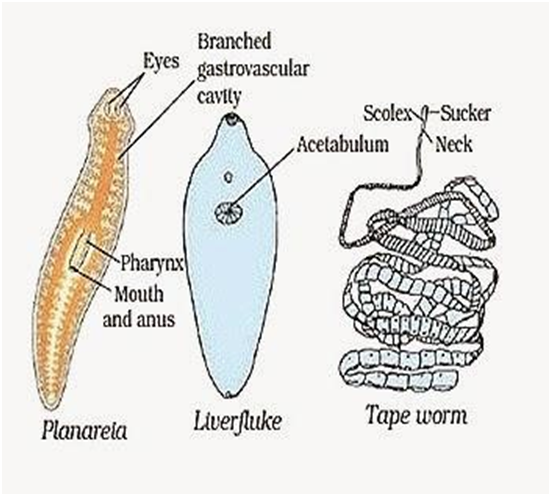
Phylum Platyhelminthes
• Level of Organization – Organs, The cells have three layers – so are called Triploblastic
• Symmetry – Bilaterally Symmetrical - Left half of the body is identical to the right half
• Segmentation – No segments
• Body Cavity/ Coelom – No so called as Acoelomates
• Presence of Organs – Yes
• Examples – Taenia solium (Tapeworm), Fasciola hepatica (Liver Fluke)
• Other Characteristics -
o They have a flat body and thus are called Flatworms
o They can be Free-living like Planaria or parasitic.
4. Phylum- Nematode
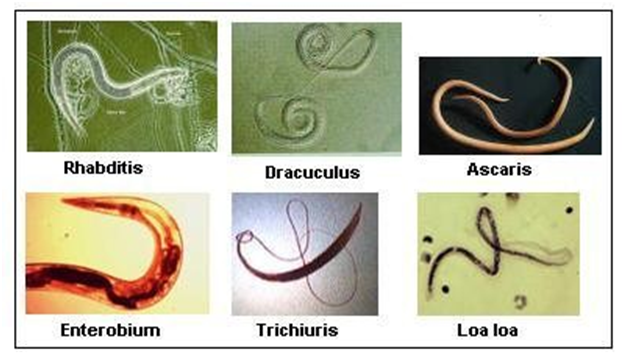
Phylum Nematoda
• Level of Organization – Tissues so are called Triploblastic
• Symmetry – Bilaterally Symmetrical - Left half of the body is identical to the right half
• Segmentation – No segments
• Body Cavity/ Coelom - False body cavity so called as Pseudocoelomates
• Presence of Organs – Organ System Level Organisation
• Examples – Parasitic worms and worms in the intestine
• Other Characteristics–
o They are called as Round Worms.
o Sexual dimorphism visible - Female and male worms are distinct.
- 5. Phylum Annelida
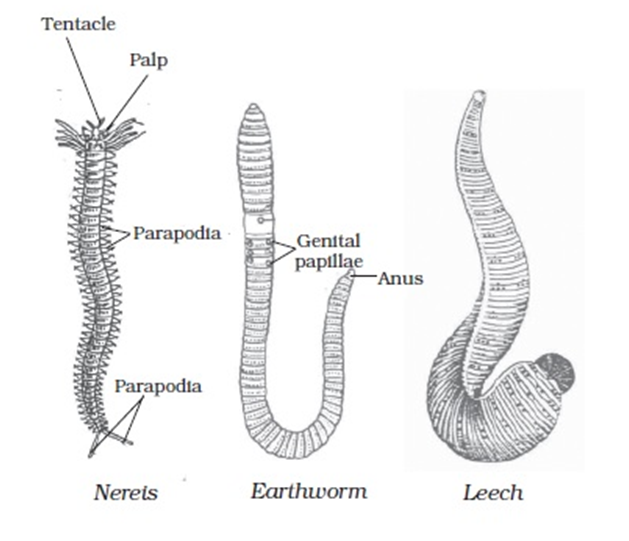
Phylum Annelida
• Level of Organization – Organ system level, the cells have three layers so called Triploblastic
• Symmetry – Bilaterally Symmetrical
• True Segmentation – Present (organs can be identified separately)
• Body Cavity/ Coelom – True body cavity so called as Coelomates
• Presence of Organs – Definite organs
• Examples – Leech, Earthworms
• Other Characteristics –
o They are found in freshwater and marine water.
o They have closed Circulatory system.
6. Phylum Arthropoda

Phylum Arthropoda
• Level of Organization – Organ systems
• Symmetry – Bilaterally symmetrical
• Segmentation – Present (organs can be identified separately)
• Body Cavity/ Coelom – True body cavity
• Presence of Organs – Definite organs
• Examples – Prawns and butterflies
• Other Characteristics
o They have jointed legs
o They have an open circulatory system – There are no well-defined blood vessels
o They have chitinous exoskeleton
7. Phylum - Mollusca
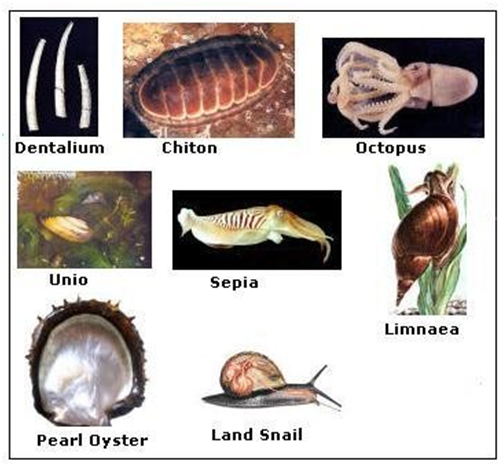
Phylum Mollusca
• Level of Organization – Organ systems, the cells have three layers– called Triploblastic
• Symmetry – Bilaterally symmetrical
• Segmentation – Little segmentation
• Body Cavity/ Coelom – Reduced
• Presence of Organs – Definite organs
• Examples – Snails
• Other Characteristics
o Body is divided into head, Visceral Mass and Muscular Foot.
o Some of the molluscs have hard external shell like that of Snails and some have internal reduced shell like that in Octopus.
o They have an open circulatory system
o There is a kidney-like organ for excretion
1. Introduction
Why do we fall ill
Introduction
Health is a state of complete physical, mental and social well-being.
Basic conditions for good health:
• Proper balanced and nutritious diet.
• Personal hygiene.
• Clean environment and surroundings.
• Healthy air, no pollution in the surrounding.
• Regular exercise.
• Proper rest.
• Good standard of living and economic status.
Disease: when the body is not at ease i.e., comfortable then it is said to have a disease.
When there is a disease, the functioning or appearance of one or more systems of the body changes.
Disease is classified as Acute and Chronic.
Acute disease: Diseases that last for only short period of time, e.g., headache, common cold etc.
Chronic disease: Diseases that last for long time,’ are called chronic diseases, e.g., elephantiasis, tuberculosis, etc.
Causes of diseases: Immediate cause and contributory cause.
Immediate cause: The organisms that enter our body and causes disease is called immediate cause. For example, virus, bacteria, protozoa etc.
Contributory cause: The secondary factors which led these organisms enter our body are called as contributory cause. For example, dirty water, unclear
surroundings, contaminated food, improper nourishment, poverty, poor standard of living etc.
Diseases may be due to infectious and non-infectious causes.
(a) Infectious causes: Diseases where microbes are the immediate causes are called infectious diseases. The infection spreads from one person to another.
(b) Non-infectious causes: Some diseases that do not spread in the community, but remains internal are called non-infectious diseases. Example, cancer, genetic abnormalities, high blood pressure etc.
2. Types of Diseases
Infectious diseases (Communicable diseases): When a disease-causing organism enters our body it causes infection, it multiplies and grows in the body called host and micro-organisms multiplies in the host body.
Non-Infectious diseases (Non communicable diseases): Diseases that are not contagious are called non-infectious or non-communicable diseases because they can't be spread from one person to another. So, there's no vector for them to move from one host to another, no virus, no bacteria, no pathogen.
Instead, these diseases are caused by other factors, such as genetics, environment, and lifestyle behaviours.
3. Mode of Transmission of Diseases
Infectious diseases spread through:
• Air: Causes air-borne diseases due to bacteria, virus e.g., common cold, influenza, measles, tuberculosis.
• Food and water: Is caused due to contaminated food and water that contains bacteria, virus, worm etc. Example, cholera, typhoid and hepatitis.
• Contact: Many diseases spread by contact of infected person with the healthy person. Examples, fungal infection, scabies etc.
AIDS and syphilis spread due to sexual contact.
• Body fluids: Body fluids like blood, semen, mother milk when infected can also cause disease. Example, AIDS.
1. Introduction and Plant Tissues
Tissues
Introduction
• Living organisms in this world comprise of cells.
• There are unicellular as well as multicellular organisms present in this world.
• In unicellular organisms, the only single cell is capable of performing several functions such as Respiration, Digestion and Clearing of the cell.
• In multicellular organisms, there is a division of labour. There are different types as well as groups of cells that perform different functions in a multicellular organism.
• Cells form groups cells that need to perform a single task often group together.
• This grouping of cells together to perform a function efficiently is called a Tissue. For Example, Muscles and Blood.
• The tissue cells have the same structure and they perform the same function.
Plant Tissues
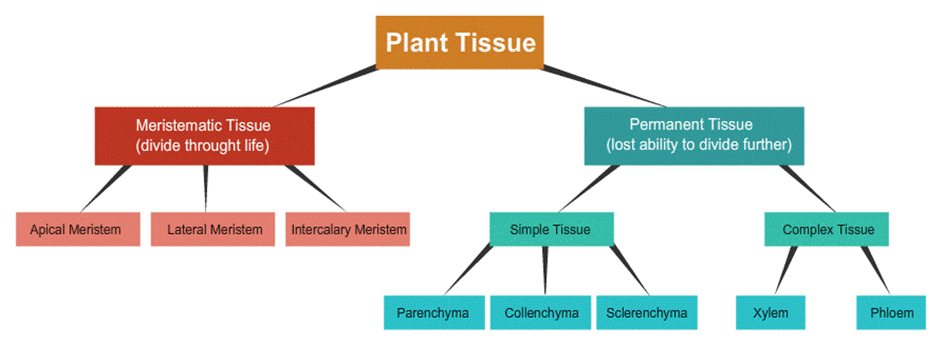
Types of Plant Tissues
Meristematic Tissue
• Only certain parts of a plant tend to grow. The tissues located in such parts are called meristematic tissues.
• They have the capability to divide themselves and form new tissues. They have thin cell wall made of cellulose. Also have dense nucleus and cytoplasm but lack vacuoles.
• They can further we classify differently based on the areas of the plants where they are located -
o Apical
o Lateral
o Intercalary
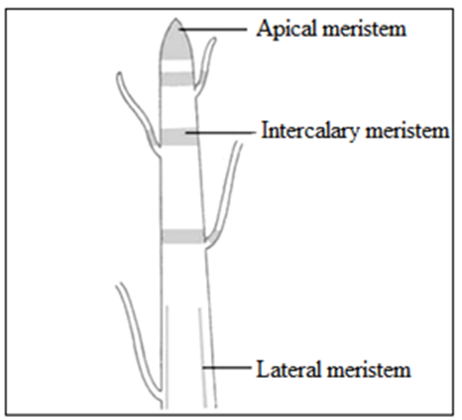
Location of meristematic tissue
|
Apical Meristem |
Lateral Meristem |
Intercalary Meristem |
|
|
|
Why there are no vacuoles in the intercalary meristem?
- Vacuoles are responsible for storage of food in water. The intercalary tissues do not store them. They are rather responsible for manufacturing them.
- Moreover, vacuoles contain sap which provides rigidity to a cell. This property of vacuoles may not allow the intercalary tissues to divide and manufacture new cells. Hence vacuoles are not present in them.
2. Permanent Tissues
Permanent Tissue
The cells that are formed by the meristematic tissues often have to take a certain role in the plant and thus, they lose their ability to divide and form more cells. They then become the permanent tissues of the plants.
- Differentiation - The process by which cells of the meristematic tissues convert themselves into a permanent tissue by taking a fixed shape, size and function is called differentiation.
- Types of Permanent Tissues:
- Simple Permanent Tissues
- Complex Permanent Tissues
- Parenchyma
- Chlorenchyma
- Aerenchyma
- Collenchyma
- Sclerenchyma
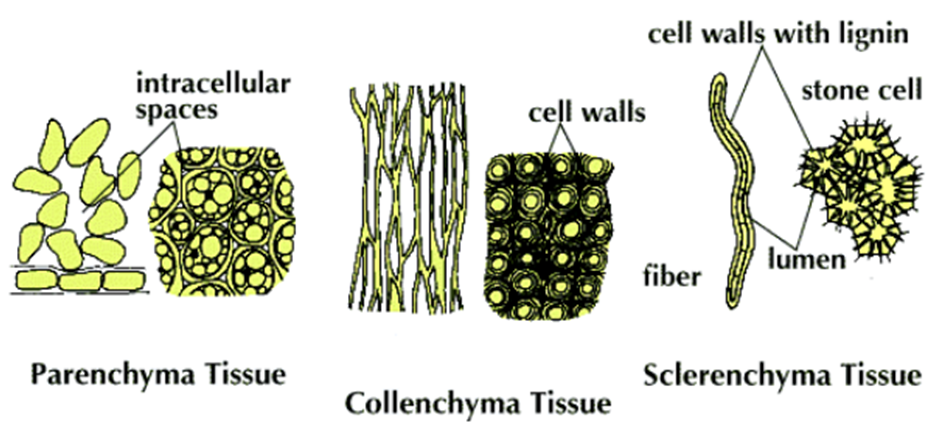
|
Parenchyma |
Collenchyma |
Sclerenchyma |
|
These tissues are responsible for photosynthesis, storage of food, gaseous exchange and floating of plants. |
These tissues are responsible for providing flexibility to the plants so that they can bend easily. |
These tissues are responsible for making plants hard and rigid. |
|
They are a group of living cells with cell wall made of cellulose. |
They are a group of living cells with cell wall made of cellulose and pectin. |
They are made up of dead cells having cell wall made of lignin. |
|
The parenchyma cells have large intercellular spaces between them. |
They have a little intercellular space in between them. |
The cells do not have any intercellular spaces. |
|
There are thin walls that surround each cell. |
The cells present in these tissues are broad and irregularly thick at corners. |
The cells have a long structure with thick walls. |
|
They are found in leaves and newly formed branches. |
They are present in leaves and stems of a plant. |
They are found in stems, veins of the leaves and coverings of nuts and seeds. |
Chlorenchyma
- These tissues are similar to that of parenchyma but they also contain chlorophyll in them.
- Due to the presence of chlorophyll, they are capable of performing the process of photosynthesis in plants.
Aerenchyma
- They are found in aquatic plants.
- They are also similar in structure to that of the parenchyma but they have large air cavities in them.
- These cavities allow the aquatic plants to float in water.
What is Lignin?
The cell walls of dead cells have a substance called lignin in them which provides rigidity to the cells. Lignin acts as the cement for the cells.
Epidermis
- The outermost layer of the cell is known as the Epidermis.
- It covers the entire plant.
- It is a thin layer of single cells but in places with less water, the epidermis of the plants can become thick in order to avoid frequent water loss.
- The cells are flat and they have no intercellular spaces between them.
- The outer walls of the epidermal cells are thick and the inner walls are thin.
- The epidermal cells often have long hair-like structures in roots which facilitate the absorption of water.
- The main function of the epidermis is to protect the plants from fungi, water loss and any injuries by secrets a wax-like water-resistant substance called as Cuticle on the surface of the plants which protects the plants.
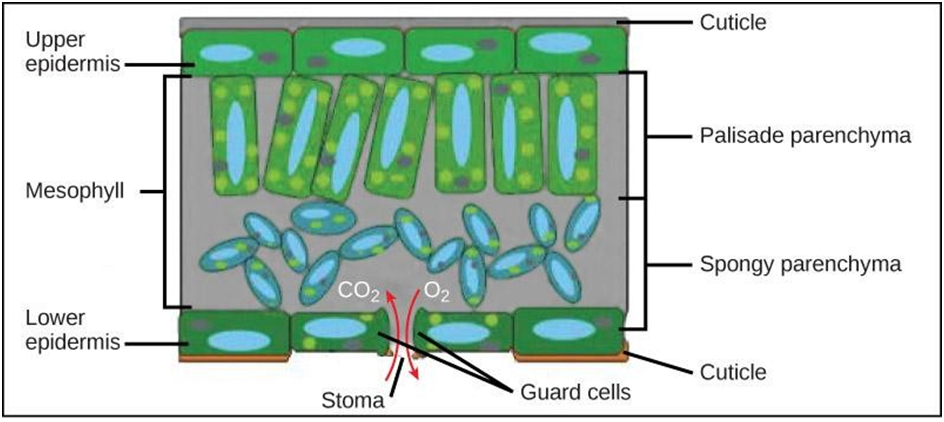
Stomata
- Stomata are pore-like structures that are present in the epidermis of the leaves.
- These pores are enclosed by two cells that have a similar shape as a kidney. These are called Guard Cells of Stomata. Guard cells are modified epidermal cells.
- Guard cells are responsible for the exchange of gases and transpiration.
Why do plants in desert areas have a waxy coating of cutin over them?
The epidermis cells of plants that are found in deserts have a waxy coating of cutin over them because it prevents water loss from the plants surface since water is already scarce in such areas.
Why do branches of old trees are different than the stems of a new plant?
- As a plant grows older the meristematic cells start covering the upper layer of the plants instead of the epidermis.
- These are the dead cells that have no special function in the plants but to provide them rigidity. They make the branches of the plants thick.
- This is often called the Bark or the thick cork of the tree.
- The bark of the trees contains a substance called Suberin which makes it waterproof and does not allow gaseous exchanges.
Complex Permanent Tissues
Complex Permanent Tissues comprise of different kinds of cells. These different types of cells coordinate with each other and perform a common function in these tissues. Two Complex Permanent Tissues are
Xylem and Phloem.
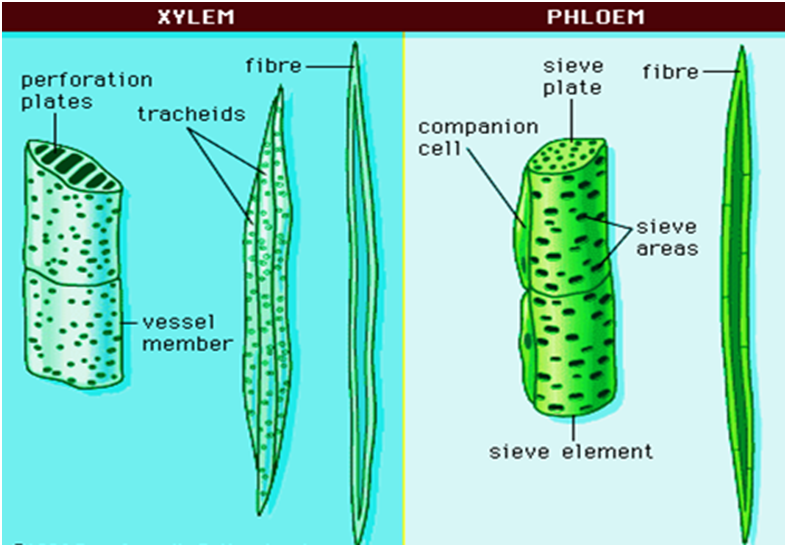
Xylem and Phloem
Similarities between Xylem & Phloem
- Their main function is to carry food and water in the plant.
- Both have a vascular bundle which is a conductive tissue in plants that helps them survive in different environmental conditions.
Xylem
Xylem is made up of dead cells having a thick cell lining. It consists of following elements-
- Tracheids and Vessels – They have broad tubular structure so that we can allow transportation of food and water in the plants vertically.
- Xylem Parenchyma – It stores food and helps in transportation of water horizontally in the plants.
- Xylem Fibers – They support transportation
Phloem
Phloem is made up of living cells and it allows the movement of food from leaves to other parts of the plant. It has the following elements –
Sieve Tubes – Broad shaped cells with porous walls
- Companion Cells – They facilitate the functions of the sieve tubes
- Phloem Fibers – Provide flexibility to the phloem
- Phloem Parenchyma – Stores starch and proteins
|
|
Xylem |
Phloem |
|
Made of |
Dead Cells |
Living Cells |
|
Cell wall thickness |
Thick |
Thin |
|
Cell wall material |
Lignin (rigid) |
Celluloses |
|
Permeability |
Impermeable |
Permeable |
|
Cytoplasm |
None |
Cytoplasm lining |
|
Transports… |
Water & minerals |
Food |
|
Carried to…. |
Leaves |
Growing parts & storage organs |
|
Direction of flow |
Upwards |
Up & down |
|
Tissue alos has … |
Fibres |
Companion cells |
3. Animal Tissues
Animal Tissues
Types of Animal Tissues
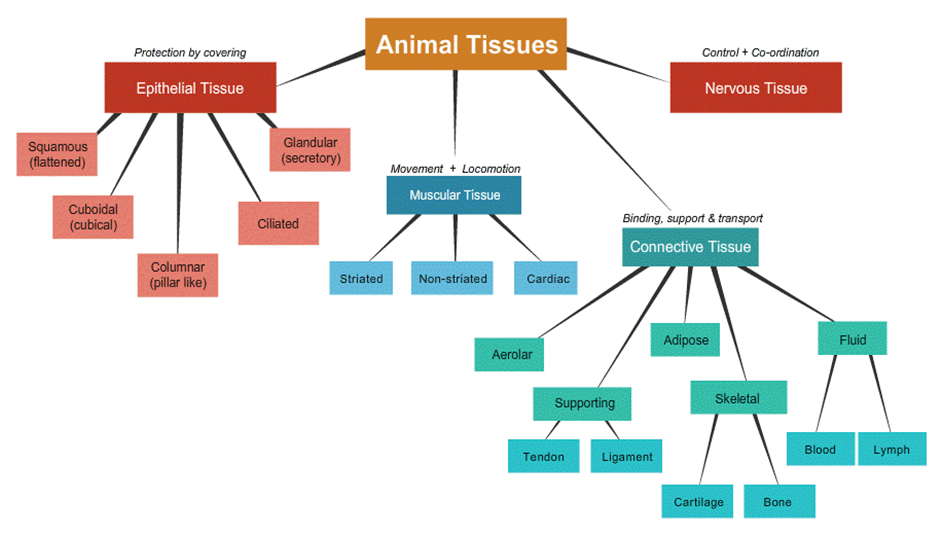
Types of Animal Tissues
-
- Epithelial Tissue
- They are the protective tissues of the human body. They cover many organs and cavities that are present inside the body.
- Where are the epithelial tissues found in the human body?
-
- The lining of the blood vessels
- The lining of the mouth
- Kidney tubules
- Skin
- Lung alveoli
Structure and functions of the epithelial tissues -
-
- The main function of the epithelial tissues is to act as a barrier and separate different organs and systems from each other.
- There is no space between the cells of epithelial tissues
- The cells are permeable. This makes it possible for them to exchange materials between different parts of the body and also between the body and the external environment.
- The epithelial tissues remain separated from the tissues beneath them because of a thin membrane over them.
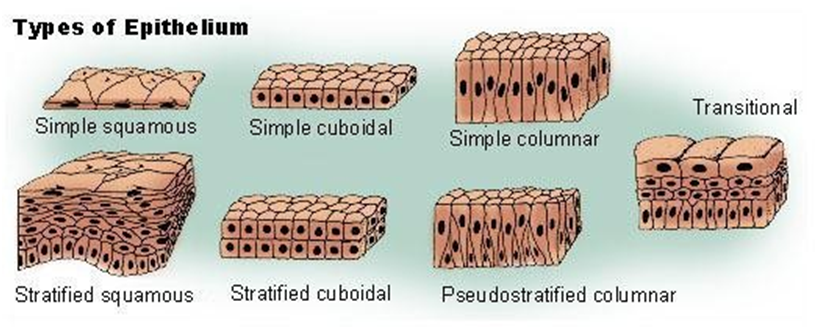
Types of Epithelium
|
Different types of epithelium tissues |
Simple Squamous |
Stratified Squamous |
Columnar |
Ciliated Columnar |
Cuboidal |
Glandular |
|
Structure |
They have delicate cell lining and possess a flat thin structure |
The epithelium Squamous cells are arranged in several layers |
They are the column-like shape tissues |
Columnar epithelial tissues which have Cilia present on them |
They are cube-shaped cells which are involved in absorption and secretion. |
These are special gland cells that can secrete substances |
|
Found in |
Alveoli and bowman’s capsule- nephron in kidney |
Skin |
Intestine |
Respiratory system |
Kidney tubules |
Sweat glands in the skin |
Connective Tissue
Structure and function of connective tissues
-
- They are loosely bound cells present in an intercellular Matrix.
- This matrix can be of different types – Dense, Rigid, Fluid or Jelly-like.
- Depending upon the functionality of the connective tissue, the nature of the matrix varies in them.
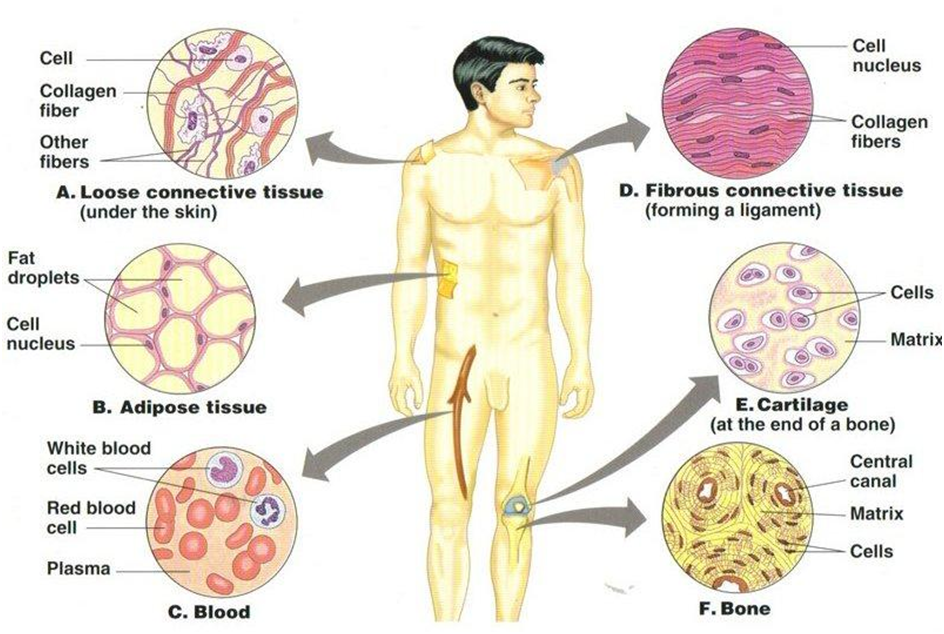
Blood
- The main function of blood is to transport gases, food, waste materials and hormones in the body.
- Therefore, blood has a fluid Matrix present in it which is called Plasma.
- The plasma contains the red blood cells, the white blood cells and blood platelets.
- The RBC have hemoglobin pigment which carries oxygen to tissues.
- White blood cells fight diseases and platelets are involved in clotting of blood when injured.
- The plasma also contains proteins and hormones in it.
Bones
- Bones form a framework of the body over which the muscles are wrapped together.
- The bone tissue is strong and inflexible in nature.
- Therefore, the bone cells are present in a rigid matrix which is formed from calcium and phosphorus.
Cartilage
- Cartilage is present over the joints of the bones and provides them with a smooth structure.
- For Example, in the nose tip and ear pinna, trachea, larynx.
- They contain solid matrix made of protein and sugar. They have homogenous matrix.
- It provides support and flexibility to various parts of our body.
Ligaments
- A ligament connects two bones together.
- It has an elasticity which facilitates the connection.
- The cells of ligaments have a little matrix.
Tendons
- The tendons tissues are responsible for connecting bones and muscles together.
- They have limited flexibility but very great strength.
Areolar
- This tissue acts as a filter in between the spaces present inside the organs of the body.
- It helps in repairing other tissues as well.
- It is found in the skin and bone marrow.
Adipose
- Fats are stored in our body in the adipose tissues.
- They are found below the skin and between the organs of the body.
- Provides cushioning to the organs.
Muscular Tissue
- It is made up of muscle fibers which are long cells.
- It allows movements in our body.
- How muscles can cause movement?
They contain special proteins called Contractile Proteins. These proteins cause contraction and relaxation of the muscles.
- There are two kinds of muscles found in our body - Voluntary Muscles and Involuntary Muscles.
|
Striated/ Skeletal/ Voluntary muscles |
Smooth/ Unstriated/Involuntary muscles |
|
We can move them according to our own will |
We cannot start or stop the movement of involuntary muscles. |
|
They are also called Skeletal Muscles as they are attached to the bones. |
They also called Smooth Muscles. |
|
They are also called Striated Muscles because of the presence of dark and light bands over them |
They are also called Unstriated Muscles because they do not have any light or dark bands on them. |
|
The cells of voluntary muscles have more than one nucleus, they do not have any branches, and have a long cylindrical structure. |
The cells of the involuntary muscles are long and have pointed ends. |
|
For Example, Muscles of our hands and legs. |
For Example, The muscles in the alimentary canal and the Iris of our eyes. |
Cardiac Muscles
- These are special kinds of involuntary muscles.
- The muscles of the heart are called Cardiac Muscles they perform rhythmic contraction and relaxation throughout our life.
- They are cylindrical in shape; they have branches and there is a single nucleus.
- Cardiac muscle consists of individual heart muscle cells connected by intercalated discs to work as a single functional organ
3. Cell Organelles and their Functions
Cytoplasm
Cytoplasm Structure
- Cytoplasm is a jelly-like substance found between cell membrane and nucleus.
- All the cell organelles are embedded in the cytoplasm. It is composed of water, organic and inorganic compounds.
- Cytoplasm is one of the essential components of the cell that is present in both plant and animal cells.
- Cytoplasm functions by controlling all the metabolic activities taking place within the cell and most of the chemical reactions are carried within it.
Endoplasmic reticulum
Endoplasmic reticulum is a network of tiny tubular structures scattered in the cytoplasm. It divides the intracellular space into two distinct compartments, one is luminal (inside ER) and another is extra luminal (outside ER). They function as the transport system of a cell, involved in transporting materials throughout the cell.
Endoplasmic reticulum is divided into two types based on presence and absence of ribosomes.
- Rough endoplasmic reticulum: The endoplasmic reticulum bearing ribosomes on their surface is called rough endoplasmic reticulum (RER). It is involved in the protein synthesis and secretion. They are extensive and continuous with the outer membrane of the nucleus.
- Smooth endoplasmic reticulum: The endoplasmic reticulum with the absence of ribosomes on its surface is called smooth endoplasmic reticulum (SER). They are responsible for lipid syntheses. In animal cells, lipid like steroid hormones is synthesized in SER. They are also responsible for detoxifying the cell.
Mitochondria
- Mitochondrion is a double membrane bound cell organelle that are not normally visible under the microscope.
- This cylindrical or sausage shaped structure is also called the power house of the cell as they are the sites for aerobic respiration of the cell and produce cellular energy in the form of ATP.
- The outer membrane and the inner membrane divide its lumen into two compartments i.e., inner compartment called matrix possessing single circular DNA molecule and a few RNA molecules. forming a number of infoldings called cristae and the outer membrane forming the continuous limiting boundary of the organelle.
- Depending on the shape, size and physiological activity of the cell, the number of mitochondria per cell are variable.
- The structure has a diameter of 0.2 to 1µm (average 0.5 µm) and length 1.0 to 4.1 µm.
Plastids
Plastids are large and membrane bound organelles that are found in all plants and in euglenoids. They contain some specific pigments that are responsible for imparting specific colours to the plants. On the basis of the type of pigment, plastids can be classified into three types.
- Chloroplasts: Chloroplasts are double membrane bound cell organelles that contain chlorophyll and carotenoid pigments that are responsible for trapping light energy and this energy is used for the purpose of photosynthesis.
Chloroplasts
The inner membrane surrounds a space called stroma. Chlorophyll containing structures called thylakoids are arranged as piles of coins and each pile is called a granum. Thylakoids are connected by flat membranous tubules known as stromal lamella.
- Chromoplasts: These include carotenoid, fat soluble pigments like carotene, xanthophyll etc. providing characteristic colours like yellow, orange, red, etc. to the plants.
- Leucoplasts: These types of plastids store nutrients and are colourless. They include amyloplasts storing carbohydrates, leucoplasts storing proteins, and leucoplasts storing oils and fats.
The Golgi Apparatus
- It is responsible for sorting, modifying, and shipping off the cellular products that come from the rough endoplasmic reticulum (ER), just like a post office.
- The Golgi apparatus is similar to stacked flattened discs, almost like stacks of oddly shaped pancakes.
- The Golgi apparatus has two distinct sides with each having a different role.
Lysosomes
- An organelle that contains enzymes that break down and digest inessential cellular components, such as a damaged organelle is called the lysosome.
- Protein products packaged by the Golgi such as digestive enzymes are meant to stay inside the cell in order to break down certain materials.
- The enzyme-containing vesicles are released by the Golgi, and they may form new lysosomes or fuse with existing lysosomes.
Vacuoles
- Vacuoles are generally characterized as storage bubbles of unpredictable shapes which are found in cells.
- They are liquid-filled organelles enclosed by a film.
- The vacuole stores the food or a spread of nutrients that a cell might need to survive.
- In addition, it also stores waste products.
- The by products are at last tossed out by vacuoles. Thus, the remainder of the cell is shielded from contamination.
- The animal and plant cells have different sizes and numbers of vacuoles. Compared to animals, plant cells have larger vacuoles.
4. Diffusion and Osmosis
Diffusion
Diffusion is the net movement of molecules of a substance from a region of their higher concentration to a region of their lower concentration. Net movement means there are more molecules moving in one direction than in the opposite direction.
Example: Opening a bottle of perfume in a room will result in the gradual diffusion of the perfume from the region of higher concentration (the bottle) out into the room. Diffusion will continue until the perfume has a more or less uniform concentration throughout the bottle and room.
Osmosis
It can be defined as the movement of water molecules from a higher water concentration area to the area of less water concentration through a semipermeable membrane. For example, water in the roots of plants is transported through osmosis.
Difference between diffusion and osmosis:
Osmosis
Diffusion
It happens only in the liquid state.
It occurs in all states of matter i.e., solids, liquids or gases.
It should be movement of only water or solvent through semipermeable membrane from lower concentration to higher concentration.
Any type of substance that moves from higher concentration area to lower concentration area.
It is applied only for the solvent part of the solution.
Diffusion is applied to all states of matter.
It requires semipermeable membrane.
This phenomenon does not require semipermeable membrane.
Osmotic Solutions
There are three different types of solutions:
Isotonic Solution
Hypertonic Solution
Hypotonic Solution
An isotonic solution is one that has the same concentration of solutes both inside and outside the cell.
A hypertonic solution is one that has a higher solute concentration outside the cell than inside.
A hypotonic solution is one that has a higher solute concentration inside the cell than outside.
Types of Osmosis
Osmosis is of two types:
Endosmosis– When a substance is placed in a hypotonic solution, the solvent molecules move inside the cell and the cell becomes turgid or undergoes de plasmolysis. This is known as endosmosis.
Exosmosis– When a substance is placed in a hypertonic solution, the solvent molecules move outside the cell and the cell becomes flaccid or undergoes plasmolysis. This is known as exosmosis.
4. Nervous Tissue
The Nervous Tissue
- How do we react to stimuli?
This is becaus e of the nervous tissues present in our body. They are capable of transmitting information quickly from the brain to different parts of the body and vice-versa.
- Therefore, nervous tissues are found in nerves, brain, and spinal cord.
- The Nervous tissue is made up of cells called the Nerve Cells or Neurons.
- These neurons connect together to form the nerves of our body.
Structure of a Neuron
-
- It is an elongated cell with a Cell Body that consists of some branch-like structure called Dendrites.
- There is a Nucleus present in the centre of the cell body.
- The Nerve Endings of the cell are connected with the cell body via Axon.
- A nerve cell can be up to 1 m long.
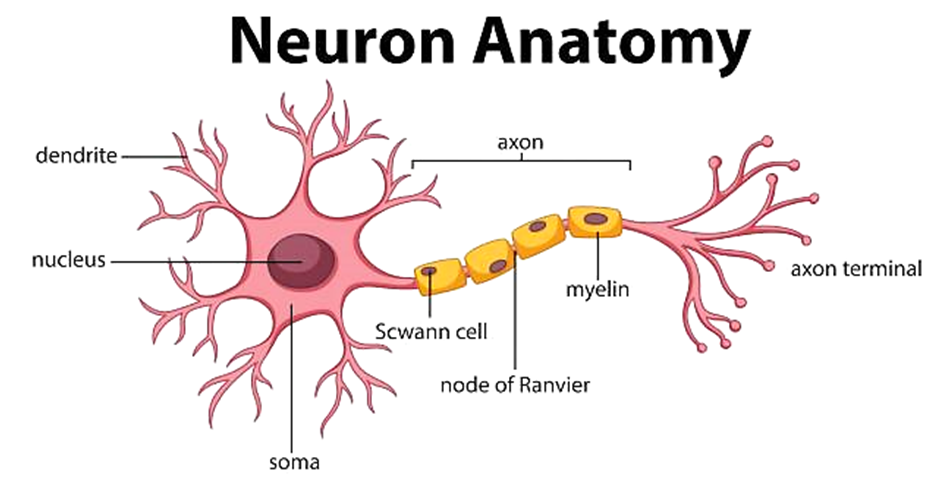
Structure of Neuron
1.Dendrites
- They are tree-like extensions (highly-branched) at the beginning of a neuron.
- They increase the surface area of the neuron.
- They receive chemical signals from different neurons of the body.
- They then convert these chemical signals into electrical signals and pass them to the neuron cell body.
- A neuron can have a single dendrite or multiple dendrites
2. Cell Body
- Also called Soma.
- The main function of the cell body and nucleus of the neuron is to maintain the functionality of the cell.
- It does not play an active role in the transmission of the signal.
- It produces proteins that are required by different parts of the neuron to work properly.
- It contains different cell organelles such as mitochondria, Golgi apparatus etc that perform various functions of the cell.
3. Axon
- Neurons have one axon in general.
- It is a long structure that connects the cell body to the terminals and it also connects with other neurons, cells and organs of the body through nerve terminals.
- It allows in fast transmission of signals. The larger the diameter of the axon the faster it will transmit signals.
- It is covered with a special insulating substance called myelin. It helps in rapid transmission of signals.
4. Symptons and Signs, Prevention of Diseases
Antibiotics: These are the chemicals (medicine, drugs) that block biochemical pathways important for bacteria. They are used for diseases caused by bacteria.
Inflammation: When an active immune system releases many cells to the affected tissue to heat-off the disease-causing microbes it is called inflammation. Local effects caused on body due to inflammation are—swelling, pain, fever and redness.
Principles of treatment
• To reduce the effects of the diseases.
• To kill the cause of the disease i.e., to kill the microbes like bacteria fungi, protozoa.
Principles of Prevention
• General method
• Specific method
General ways of preventing infections relate to preventing exposure.
Prevention of exposure can be done by following ways:
• For air borne infections—valid -visiting public place, cover your nose and mouth while coughing.
• For water borne infections- Drink, clean and boiled drinking water.
• For vector borne infections Keep the surroundings clean, do not keep any puddle of water open in the surrounding as it allows the breeding of mosquitoes.
• Self-immune system that can (fight off and kill microbes when it enters our body.
• Availability of proper and sufficient -food for everyone.
Vaccination & Immunization
• Vaccination: The use of vaccines to stimulate your immune system to protect you against infection or disease
• Immunization: The process of making you immune or resistant to an infectious disease, typically via vaccination

 Science Made Easy
Science Made Easy
 ACERISE INDIA
ACERISE INDIA
